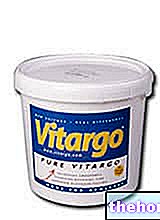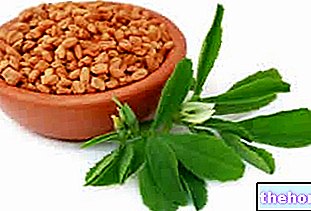
L-Arginine - Chemical Structure
Normally taken in quantities between 3.5 and 5 grams per day, especially through meat, dried fruit and vegetable foods rich in proteins (legumes), Arginine could become essential even in adults subjected to particularly restrictive diets, stress important psychophysical or physical trauma.
Arginine content of food

By virtue of its biological role and excellent tolerability, L-Arginine has, for several years now, become a particularly used supplement in both clinical and sports fields.
classified as conditionally essential, as it plays a key role in some physiological moments of life, such as adolescence and puberty, and in the course of some pathological conditions such as extensive trauma and burns.Years and years of studies have allowed us to characterize the biological functions of L-Arginine, identifying some of them of vital importance for the human organism. Below is a list of some of the most important biological functions of Arginine:
- Synthesis of glucose in particular metabolic conditions (gluconeogenesis);
- Protein synthesis;
- Synthesis of Creatine and other amino acid derivatives, fundamental in the cellular economy;
- Detoxification of nitrogen residues;
- Synthesis of nitric oxide, a fundamental element with vasodilating power;
- Immunostimulating action;
- Antioxidant action,
For this reason, the integration with L-Arginine has become essential in the course of cardiological diseases, hypertension, dysmetabolism, surgical trauma, severe burns and disorders of male fertility.
With some skepticism, the use of L-Arginine has also been welcomed by sports dietetics, due to its possible myoprotective, anabolic and structural activity.

For these reasons, despite the constant presence of conflicting opinions, there are numerous studies relating to the potential benefits deriving from the use of L-Arginine as a supplement.
L-Arginine and cardiovascular function
The effects of supplementation with L-Arginine on cardiovascular health are very interesting.
Starting from initially only experimental evidence, the use of Arginine has established itself in the cardiology field due to its different modes of action.
More precisely, adequate supplementation with Arginine would have proved useful in patients suffering from hypercholesterolemia, hypertension and angina pectoris, in reducing vascular damage, improving cardiac perfusion, reducing oxidation of LDL lipoproteins and improving the rheological characteristics of the blood.
These activities appear to be attributable both to a direct effect on the vascular walls and to the production of vasoactive mediators such as nitric oxide.
L-Arginine and fertility
The numerous clinical trials published in this regard seem to agree on the usefulness of L-Arginine in improving the motility and quality of spermatozoa in patients with oligospermia.
This activity would seem once again linked to the vasodilator and antioxidant effect of L-Arginine. The potential use in the treatment of erectile dysfunction is illustrated in this article.
L-Arginine and trauma
The immunomodulating activity on the one hand and the ability to induce the synthesis of Proline, an amino acid abundant in collagen, on the other hand, would justify the key role of L-Arginine in facilitating the structural and functional recovery of the injured tissue.
This activity would have been particularly valuable during major surgeries, extensive injuries or severe burns.
L-Arginine and immunity
The integration with L-Arginine would have proved to be particularly effective, especially in defunct subjects (such as patients with HIV), in improving the immunological structure.
In particular, the integration of arginine helps to enhance the synthesis and activity of cytotoxic lymphocytes and Natural Killers cells, dedicated to the protection of the organism against exogenous pathogens and neoplastic cells.
L-Arginine and sport
The use of Arginine in sports is currently justified by the antioxidant and immunomodulating role, especially valuable during particularly intense training sessions, rather than during prolonged competitions.
No less important would be the potential ergogenic role, linked to the gluconeogenic activity of Arginine, and the detoxifying role against nitrogenous waste, usually higher in athletes.
For a long time it was believed that supplementation with L-Arginine could contribute to the increase in the endogenous secretion of growth hormone and the like. This activity, observed above all in elderly, defunct, sarcopenic and generally in hospital patients, would not result instead appreciable in healthy and trained individuals, thus dispelling a myth still in vogue.
The dosages currently used in the literature are multiple and generally comprised between 3 and 20 g per day, evidently divided into several assumptions.
In sports, the most used daily dose of Arginine is that of 3 grams, generally taken in the pre-workout phases or before night rest; in the cardiology or andrology field, on the other hand, the dose can rise up to 10 g per day.
, nausea, vomiting and diarrhea.
Fortunately, the incidence of headache, hypotension and nephrotoxicity, mostly related to the parenteral administration of L-Arginine, is rarer.
The aforementioned contraindications could also extend to severe cases of hepatic and renal insufficiency.
such as Cyclosporine, Ibuprofen, organic nitrates, Sildenafil citrate and plants with phytotherapeutic activity such as Yohimbe.
For these reasons it would be advisable to consult your doctor, before taking supplements based on L-Arginine, if a drug therapy was in progress.
Given the presence of L-Arginine in the viral proteins of Herpes Simplex, some authors suggest avoiding the use of Arginine-based supplements in patients predisposed to infection, in order to reduce the risk of any re-exacerbations.




























